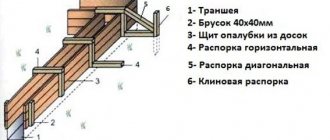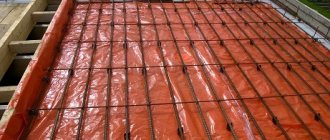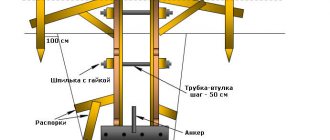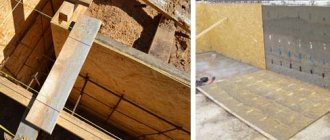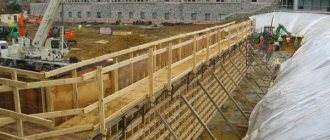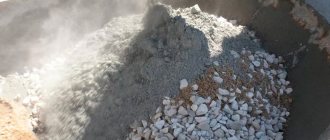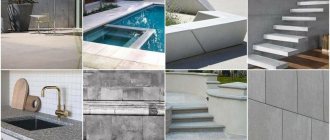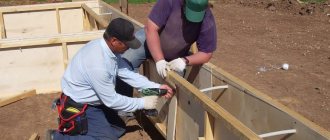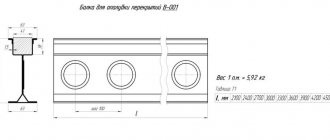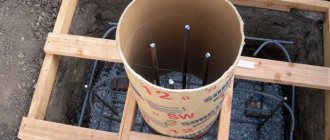What formwork is used
Monolithic formwork is used to construct a wide variety of structures, so there are many varieties of it. Depending on the purpose, the following formwork options are distinguished:
- Vertical. This option is used to build the foundation and walls.
- Horizontal. Used for the construction of floors.
- Curly. This is a rare option, used for the construction of structures of unusual configuration, for example, with rounded walls, as well as for casting columns.
- Crawling. Indispensable if you need to create a surface with a slope.
The equipment can be removable and is used temporarily. As soon as the concrete hardens, the structure is dismantled. Then it can be reused by collecting it in another place. Stationary formwork is also used, which becomes an integral part of the cast part.
Fixed
For the manufacture of stationary formwork for a monolith, in most cases, extruded polystyrene foam is used. A non-removable monolithic structure is assembled from plates of materials, but a more convenient option is a block form, which is assembled like a children's construction set.
To fasten the forms from the plates, special plastic ties are used, which keep the panels from moving apart after pouring the solution. The choice of this formwork option is beneficial from an economic point of view, since polystyrene foam forms not only perform the functions of formwork, but also provide additional thermal insulation.
Elements of aluminum formwork
Aluminum formwork consists of the following elements:
- Shields. They can have different sizes; there are main panels and extensions - corner and hinged.
- Struts. These are devices for strengthening assembled forms.
- Fasteners – ties, locks, clips.
The dimensions of the main sheets are as follows:
- width: minimum value 25 cm, then there are sheets with a width from 30 cm to 1.2 meters in increments of 0.1 meters;
- length: from 3 to 3.3 meters;
- The average weight of the shield is 30-35 kg/m2.
Advice! If necessary, you can order the production of aluminum frames to individual sizes, but such kits will cost more.
What is better to use for formwork
Fixed
When planning to use monolithic construction technology, you need to decide on the choice of formwork option at the planning stage. In this case, you need to take into account:
- volume of planned work;
- characteristics of the facility being built;
- financial opportunities.
In the professional field, steel or aluminum kits are more often used. In private construction, the most popular options are formwork forms made of boards or plywood.
Gamma formwork rental in Moscow
Renting gamma formwork in Moscow can be complicated by encountering scammers. That is why you should not focus only on the low cost of the product. PTK RentaStroy has been providing construction sites with high-quality equipment for many years. We work legally, strictly following the legislation of the Russian Federation. We provide appropriate certificates for the offered equipment. You can contact us online or by phone. A highly qualified manager will help you choose the optimal system that meets your needs and capabilities.
Different situations require different systems. We will help you choose what will really be the answer to your existing problems. In cases where the formwork is used as waterproofing, it is necessary to make sure that it is waterproof and can perform the functions assigned to it.
Installation instructions for formwork
Above are general instructions for installing formwork of any type. But when assembling forms for foundations, walls and ceilings, there are special nuances that you definitely need to know about.
Foundation
When installing formwork for strip foundations, panels made of boards or plywood are often used. It is these elements that bear the main load exerted by the concrete solution.
The strength and service life of the entire building depends on how correctly the formwork for the foundation is assembled, since the foundation is its basis. Before starting the construction of the foundation, it is necessary to carry out a number of preparatory measures.
At the initial stage, it is necessary to familiarize yourself with the requirements of the project, in addition, it is necessary to take into account the climate. It is advisable to carry out work at positive temperatures, that is, in late spring or summer, when frosts are unlikely.
If you plan to build the most common version of formwork from boards, then the procedure should be as follows:
- On the prepared site, the corners of the foundation to be poured are marked. The remaining elements will be attached to these bars;
- the distance between the bars is measured and, depending on the results obtained, boards are assembled from the boards;
- they knock together the shields using bars, which should remain on the outside of the forms;
- shields are made in duplicate, since these elements are installed opposite each other;
- The shields are sealed, in addition, their internal surface is treated, it should be as smooth as possible;
- the shields are installed between the corner bars, securely fastening the elements to each other. From the outside they are strengthened by installing slopes. The spacing of these elements depends on the thickness of the foundation and ranges from 0.5 to 1 meter. Inside, the boards are fastened by installing ties.
- The inside of the assembled formwork forms is lined with thick polyethylene film or roofing felt, and the waterproofing material is secured with self-tapping screws. This will help prevent the solution from leaking out through the cracks. It is recommended to pour crushed stone or sand at the bottom of the molds so that the liquid from the solution does not absorb into the soil too quickly;
- Before pouring the solution, you must once again check the horizontal and vertical positions of the installed elements.
We invite you to familiarize yourself with Insulation of stove pipes: non-flammable materials for thermal insulation of stove pipes and floors
When assembling formwork for erecting walls, the installation technology differs little from the technology for assembling foundation forms. Two types of wall formwork are used:
- small-panel - assembled from relatively small panels of laminated plywood or plastic. This equipment is suitable for the construction of small objects, for example, low-rise buildings;
- large-panel – characterized by the presence of large-area shields. Used for the construction of large objects, for example, multi-storey buildings.
The distance between the panels depends on the thickness of the walls. When assembling forms, you should take into account the need to leave openings for windows and doors. The panels are dismantled after the concrete solution has completely hardened.
Floors
When installing floor formwork, horizontal forms are assembled at height. The installation option depends on the planned ceiling height. Most often, structures on telescopic racks are used; they can be used if the ceiling height does not exceed 4.5 meters.
Tripods are mounted at the bottom of the racks for stability, and universal forks are attached to the top. These forks are used to secure the support beams, on top of which the cross beams are laid.
The horizontal part of the form, the deck, is laid on top of the beams. And along its perimeter, vertical sides are installed, their height depends on the design thickness of the floors.
Fixed
Installation of permanent formwork is simpler than assembling adjustable forms. To assemble permanent formwork, special blocks of foamed polystyrene are produced. Other material options are used much less frequently - reinforced concrete, wood concrete, metal.
Expanded polystyrene blocks are installed on a pre-prepared base. If this is wall formwork, then they are placed on a ready-made foundation, covered with a layer of waterproofing. The blocks are placed on top of reinforcement bars protruding from the foundation. The lateral connection of adjacent blocks occurs due to the fastenings available on them.
So, installation work on formwork assembly is an extremely important stage in the construction of a building. Not only the appearance of the cast structure, but also its strength characteristics directly depends on the quality of the work performed. Therefore, installation must be carried out with special attention and all technological requirements must be carefully followed.
Inexpensive rental of gamma formwork
Today, permanent formwork made of expanded polystyrene is gaining more and more consumer attention. It replaces wall insulation, as it has sufficient noise and heat insulating properties. Once installed, this system does not require dismantling. And despite its apparent lightness, it is reinforced with vertical and horizontal rods, which adds weight and rigidity to the concrete structure. will help you rent gamma formwork inexpensively . We set reasonable prices, a flexible system of discounts, and hold seasonal promotions. Cooperating with us is simple and comfortable.
DIY installation
Installation of formwork forms is an important stage in the construction of any monolithic structure. The nuances of installation depend on the type of object being built, but there are general recommendations. Work begins with preparing the work site and marking.
If small panel kits are used, the size and weight of which allow the work to be done manually, then installation is carried out by workers. When using large and heavy shields, work is carried out using load-lifting cranes.
We suggest you familiarize yourself with How to install a box under a socket or switch
As a rule, the installation of elements starts from the corner. The shields are installed first along the internal and then along the external contour. From the outside, fastening is carried out by installing stops; from the inside, special couplers are mounted. Dismantling work begins only after the cast concrete has gained sufficient strength. Dismantling work is carried out in reverse order.
So, the construction of formwork for monolithic construction is an integral part of the work. But dismantling work is only necessary if an adjustable type of equipment is used. Stationary forms remain in the building structure for the entire service life. The choice of formwork equipment option depends on the type of structure being erected and operating conditions.
Prefabricated formwork for creating monolithic reinforced concrete structures consists of panels or blocks connected by fasteners and reinforced with supports. The nuances of assembly depend on the type of formwork and the material of its manufacture.
But there are also general installation rules. Therefore, it is worth getting acquainted with the peculiarities of the work. When performing installation work, the following rules must be observed:
- Before starting installation, it is important to thoroughly clean the construction site; it is necessary to remove debris, snow, ice, etc.;
- Leveling the site is carried out by cutting the soil. Adding soil is strictly prohibited;
- elements are installed starting from the corner. Corner elements are a kind of beacons along which the main structure is aligned;
- when installing elements, it is necessary to pay attention to the verticality and horizontality of the elements;
- before pouring the solution, you must ensure that the structure is tight; all joints must be sealed;
- Before installation, the inside of the panels should be coated with a special compound that will prevent the concrete mixture from sticking to the formwork.
Homemade concrete retaining wall
If the slope of the surface of your site is not too large, then making a concrete retaining wall with your own hands will not be difficult. For example: you need to build a retaining wall 1.2 m high (above ground level). In order to save building material (rebar and concrete mortar), we recommend choosing a thin-walled corner retaining wall with a T-shaped base. How to make a concrete retaining wall (three main steps):
Preparatory stage
First we prepare a sketch, drawing and reinforcement diagram.
Then we begin land work. We make markings using pegs and construction cord. We dig a trench of the required width (slightly larger than the width of the support, taking into account the formwork) and depth (taking into account the thickness of the support and the cushion of sand and crushed stone). We store the earth from the trench in a free area (later it will be needed for backfilling on both sides of the wall). We pour sand into the bottom of the trench (the thickness of the layer is about 0.2 m) and tamp it down (wetting it periodically with water). Then we fill in the same layer of crushed stone and also compact it (with a vibrating plate or a hand tamper). We lay geofabric on top of the equipped pillow.
Formwork and grouting
Now let's start creating the reinforcing frame. The reinforcing bars of the “sole” and “body” of the wall must be connected to each other.
We are building formwork. First we do it only for the foundation of the wall. After this, we pour concrete mortar along the entire length of the foundation and compact it using a vibrator. After the mortar has set, we proceed to installing the formwork of the supporting wall itself. The manufacturing technology of formwork and the materials used for its manufacture are similar to the arrangement of a strip foundation.
Important! In the process of arranging the formwork, it is necessary to lay transverse plastic or asbestos-cement pipes into it to drain groundwater and precipitation penetrating into the soil (the lower edge of the pipes should be slightly above the ground level on the outside of the supporting wall). This will significantly reduce the load on the inside of the vertical slab. The distance between transverse drainage pipes is 1.0÷1.5 m.
Then we begin pouring the concrete retaining wall.
Attention! To prevent the formwork from collapsing or deforming during pouring, it is better to carry out this process in stages. First, fill the solution to ⅓ of the height along the entire length of the wall. Then we vibrate the poured solution. Next, fill the formwork with the solution another third, and so on.
To ensure maximum strength and uniformity, it is advisable to fill the entire structure in one day. After the solution is poured to the upper edge of the wall and completely compacted, the surface is leveled and covered with plastic wrap and left for final drying. To prevent rapid evaporation of water from the solution (which can negatively affect strength), in hot weather the surface of the solution is periodically wetted.
Related article: How to properly prepare walls for wallpapering
Waterproofing and arrangement of drainage system
After 7–9 days, we begin dismantling the formwork. To ensure durability, concrete wall surfaces are covered with a waterproofing material (for example, a special composition based on liquid rubber).
Next, we proceed to arranging a drainage system for a concrete retaining wall using the following technology:
- Along the entire length of the wall from the inside (that is, from the side of the slope), we lay a perforated pipe (necessarily wrapped in water-permeable geofabric).
- Then we fill this pipe with crushed stone.
- We lay geotextiles on top of the crushed stone (to preserve the free space not filled with soil between the individual particles of crushed stone).
- We take the free end of the pipe (on one or both sides of the wall) into a drainage ditch (or well) or the nearest drainage basin.
At the final stage, fill the free space around the wall with soil.
Important! We begin backfilling the soil only after the concrete retaining wall has gained its final strength and can withstand significant loads from the slope, that is, no earlier than in a month.
Next, we proceed to decorating the visible part of the constructed retaining wall. For these purposes, facing tiles, natural or artificial stone are usually used.
Formwork for monolithic construction: price in Krasnodar, Astrakhan
carries out the manufacture of formwork equipment, which is very popular throughout Russia and abroad. The products are used in the construction of housing, shopping centers, office and administrative buildings, bridges, parking lots and other facilities. Our clients are large construction companies and private customers.
We always have plywood and metal (aluminum, steel) products in stock. Each type has its own scope of use.
Prices are indicated on the website. Please note that we adhere to a flexible pricing policy and are always ready for dialogue.
